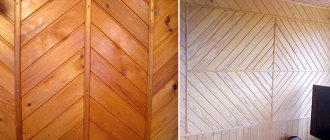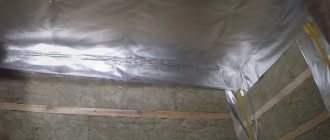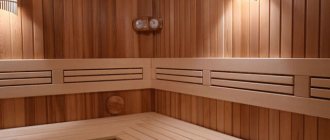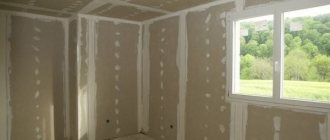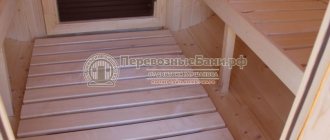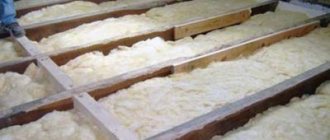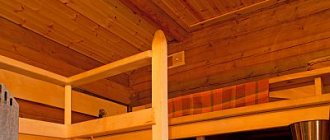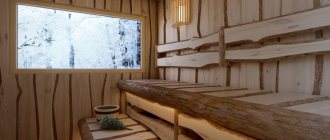Building a bathhouse on your own site is a great idea. The most common issue in this mission is the walls of the dressing room. It is this part of the steam room that is most susceptible to corrosion and is influenced by high temperatures. Condensation often forms in the waiting room due to temperature changes and poor ventilation. Therefore, you should be careful about the walls in this room.
Decoration of walls and interior in the dressing room
Option for the interior and arrangement of the dressing room
Of course, you can periodically completely renew the structure of the bathhouse, but why if it is expensive and requires a lot of labor? It is much more prudent to prepare in advance for the first stage of organizing the space, so as not to feel discomfort and large financial expenses. To do this you need:
- Understand which materials to give preference to when decorating walls so that the structure will last for many decades;
- Decide on options for ventilation of the waiting room space;
Examples of ventilation devices in the waiting room - Decide what protective agents will be used to treat the walls;
- You should also roughly calculate how much material is needed to process the walls in the dressing room. This will help you understand how much money needs to be spent on raw materials for the proper organization of the walls in the dressing room.
All these questions will help in the process of erecting the structure of the bathhouse, in particular the walls of the dressing room.
Option for planning a bathhouse and dressing room made of logs
Installation of lighting in the dressing room
PVC panels in the construction of a bathhouse - how practical is it?
The construction and renovation of baths is usually accompanied by the question: “What is best to use as wall decoration?” Natural wood, for all its advantages, also has a number of disadvantages, which cannot always be overcome. This flammable material requires special handling and special care. In addition, covering walls with natural material is quite expensive.
In the last 8-10 years, bathhouse builders have been paying more and more attention to PVC plastic panels, which not only are not inferior in quality to natural materials, but also in some ways surpass them.
First of all, this new wall decoration for Russia, samples of which can be found at https://www.uniproc.ru/catalog/, is environmentally friendly enough to be used in the repair and construction of baths.
It is clear that a certain prejudice about PVC - a thermoplastic polymer of vinyl chloride - is embedded in us, one might say, at the genetic level. But “everything flows, everything changes,” and modern samples of PVC panels use non-toxic ingredients, the suitability of which for the production of materials for finishing premises such as bathhouses is confirmed by certificates of compliance with environmental standards. Some modern PVC panels can withstand temperatures of about 115 degrees Celsius.
The quality of PVC panels such as fire safety is also important for the construction and repair of baths. The plastic from which they are made does not burn, but melts. Moreover, it does not emit harmful substances and does not contribute to the spread of open fire.
PVC panels are easy to clean, so achieving a clean and well-groomed room when using them as a finishing material for walls is quite simple.
If we talk about the shelf life of panels of this type, then here they have no equal. With proper care, PVC panels last a long time, while they retain not only their integrity, but also almost their original appearance.
By the way, about appearance: from an aesthetic point of view, PVC panels are beyond praise. Manufacturers supply samples of these products of various designs and sizes. As a rule, the panels come complete with moldings, baseboards and end strips, which allows you to give the interior a curtained and neat look.
The undeniable advantages of PVC panels also include the fact that installing a PVC surface is quite simple. Most of the panels have a tongue-and-groove locking system.
As practice shows, for finishing the walls of a bathhouse it is best to use panels whose width is in the range of 150-250 mm and thickness 80-100 mm. In rooms with high humidity, it is recommended to install PVC panels on a wooden sheathing; waterproofing material must be laid between the sheathing and the wall. This will protect the bathhouse from condensation.
If you liked the article, you can share it with your friends or add it to your favorites. In addition, you will bring significant benefits to this site. Thank you!
Source of the article: https://24banya.ru/digest/paneli-pvx-pri-stroitelstve-bani-naskolko-eto-celesoobrazno-2.html
How to line the inside of a bathhouse cheaply?
Exotic wood species are very beautiful: abashi, meranti, cedrella. At the same time, the array brought from Africa and South America looks impressive, but expensive. The simpler cladding of a bathhouse with unedged boards from rocks from the middle latitudes of Russia is slightly inferior in density, and the price is lower. The bark is removed from the tree, the surface is sanded, and coated with water and biocidal agents. After drying, the boards for interior finishing are ready.
Which clapboard is better to cover the walls?
A popular finishing option is thin slats made of linden, aspen, cedar, and white acacia. They are aesthetically pleasing, tolerate the aggressive conditions of the steam room well, and immediately transfer the accumulated heat into the air. Preference is given to eurolining with long tongues in a tongue-and-groove locking system, compensation holes for ventilation, impregnated with protective agents.
But if you are looking for something to decorate the inside of a bathhouse besides lining, study the following materials:
- block house;
- glass magnesite;
- ceramic tile;
- fireproof ceramics,
- heat-resistant stone tiles made of serpentine, jadeite, serpentinite;
- salt blocks.
Porcelain tiles can be laid on the floor, and tempered frosted glass can be mounted on the ceiling of the steam room.
Plastic panels as a finishing material for the waiting room and washing area in the bathhouse
Hello! I want to decorate the ceilings and walls of the dressing room and sink with plastic panels. Before there was lining, I got tired of it. Please advise - is it possible?
PVC plastic panels are an inexpensive, but quite worthy alternative to worn-out and boring lining in your bathhouse. Unlike the steam room, the dressing room and washing room do not have too high temperatures, and therefore the main requirement for the finishing materials of these rooms is hygiene, that is, they must be easy and quick to wash. Plastic panels fully meet this requirement and also have other useful properties.
Separate washing area
In this case, the list of possible materials significantly expands. Just as in the previous case, you can use wood. The technology for performing the work remains the same. Three more options are added to the lining:
- ceramic tile;
- natural or artificial stone;
- plastic panels.
When choosing a cladding method, it is important to consider several material requirements:
- moisture resistance;
- resistance to high temperatures;
- environmental friendliness;
- safety.
Advantages of plastic panels
- Aesthetics. The variety of designs and a wide range of standard sizes allows you to create beautiful interiors, and the range of skirting boards, connecting moldings, and end strips give the finishing of PVC panels a finished, neat look.
- Environmental friendliness. Non-toxic raw materials are used for the production of plastic panels; the finished products meet all environmental requirements for materials for finishing premises for any purpose, including children's and medical institutions.
- Fire safety. Polyvinyl chloride, from which plastic panels are made, is non-flammable; in the event of a fire, it melts and does not contribute to the spread of open fire.
- Hygiene. Plastic panels lend themselves well to both dry and wet cleaning using non-abrasive detergents.
- Durability. With proper use, the service life of plastic panels can be calculated for many years and their appearance is preserved.
Features of selection and installation
The range of standard sizes of PVC panels offered on the market represents a wide selection of products with a standard length of 300 cm, width of 15-50 cm, thickness of 5 or 8-10 cm. Most manufacturers supply them with a European tongue-and-groove locking system, which simplifies installation.
Important! The range of connecting moldings is available only for panels with a thickness of 8-10 cm.
The optimal choice of material for finishing the walls and ceiling of your dressing room and washing room is PVC panels 15-25 cm wide and 8-10 cm thick.
Sometimes, in rooms with perfectly smooth and dry walls, installation of PVC panels is allowed directly on the wall, onto which a water-repellent composition is first applied, and the joints are treated with sealant.
When finishing the ceilings and walls of dressing rooms, showers, bathrooms and other rooms with high humidity, it is recommended to install the panels on a wooden or aluminum sheathing, which provides an air gap between the wall and the cladding to protect against condensation.
It is advisable to lay a layer of any waterproofing material between the wall and the sheathing.
Video instructions will help you quickly master the simple rules for finishing the walls and ceiling of any room using aluminum sheathing.
Thus, finishing your bathhouse's dressing room and washing area with plastic panels is both possible and advisable.
Source of the article: https://strmnt.com/vopros/plastikovye-paneli-dlya-predbannika-i-moechnoj.html
Ceramic tile cladding
Finishing the washing area in the bathhouse with tiles is done only for the walls. The advantages of this material include high strength, durability and resistance to high humidity. Now manufacturers offer a wide range of different colors and textures, from which it is easy to choose the right option. The disadvantages will be the complexity of the work and the large volumetric weight of the tiles.
We invite you to familiarize yourself with: Options for brick stoves for baths
Wall tiles are used in both brick and wooden baths. Before starting work, you need to carefully select the adhesive solution. It must be designed for wet areas. When choosing tiles for a wooden building, you should carefully consider the load-bearing capacity of the walls. If they are thin, it is recommended to choose a lighter cladding.
The work is performed in this order:
- Preparation of walls, caulking, leveling, treatment with antiseptic compounds.
- Covering walls with waterproofing material. For this, roofing felt is often chosen. You can also consider more modern analogues, for example, linochrome or hydroisol. The waterproofing is attached with an overlap of at least 10 cm using a construction stapler.
- A fine mesh netting is sewn on top of the waterproofing. A layer of cement mortar is applied on top of it. It should completely cover the mesh.
- Installation of tiles begins from the lightest corner. To clad the walls around the perimeter at floor level, a wooden beam or metal profile is nailed. Its evenness is checked using a building level. This beam will become the support for the first row of ceramics.
- The tiles are laid from below using glue, which is applied to the back of each element. To ensure evenness of the seams, special crosses are used.
- After finishing is completed, all seams are rubbed with a hydrophobic compound.
Tiling is recommended only up to a height of 1.8 m. Everything higher is plastered and covered with water-based paint.
PVC panels in the construction of a bathhouse - how practical is it?
The construction and renovation of baths is usually accompanied by the question: “What is best to use as wall decoration?” Natural wood, for all its advantages, also has a number of disadvantages, which cannot always be overcome. This flammable material requires special handling and special care. In addition, covering walls with natural material is quite expensive.
In the last 8-10 years, bathhouse builders have been paying more and more attention to PVC plastic panels, which not only are not inferior in quality to natural materials, but also in some ways surpass them.
First of all, this new wall decoration for Russia, samples of which can be found at https://www.uniproc.ru/catalog/, is environmentally friendly enough to be used in the repair and construction of baths.
It is clear that a certain prejudice about PVC - a thermoplastic polymer of vinyl chloride - is embedded in us, one might say, at the genetic level. But “everything flows, everything changes,” and modern samples of PVC panels use non-toxic ingredients, the suitability of which for the production of materials for finishing premises such as bathhouses is confirmed by certificates of compliance with environmental standards. Some modern PVC panels can withstand temperatures of about 115 degrees Celsius.
The quality of PVC panels such as fire safety is also important for the construction and repair of baths. The plastic from which they are made does not burn, but melts. Moreover, it does not emit harmful substances and does not contribute to the spread of open fire.
PVC panels are easy to clean, so achieving a clean and well-groomed room when using them as a finishing material for walls is quite simple.
If we talk about the shelf life of panels of this type, then here they have no equal. With proper care, PVC panels last a long time, while they retain not only their integrity, but also almost their original appearance.
By the way, about appearance: from an aesthetic point of view, PVC panels are beyond praise. Manufacturers supply samples of these products of various designs and sizes. As a rule, the panels come complete with moldings, baseboards and end strips, which allows you to give the interior a curtained and neat look.
The undeniable advantages of PVC panels also include the fact that installing a PVC surface is quite simple. Most of the panels have a tongue-and-groove locking system.
The original way of finishing from
It is not recommended to use synthetic materials as floor coverings. In this case, ceramic tiles or wood are used. The texture of the tile should be chosen so that it prevents slipping. You can also lay wooden gratings on the tile floor to avoid injury.
Wooden floors must be treated with an antiseptic composition and protected from moisture. To increase water-repellent characteristics use:
- wood varnish (renewed every 5-7 years);
- tinting (every 2 years);
- oil (once a month).
To extend the service life of walls, floors and ceilings, it is worth taking care of ventilation. If natural ventilation is not enough (when using tiles, plastic, stone as cladding), a forced system (exhaust) can be used. This option will require additional financial investments, but will ensure a comfortable microclimate and prevent frequent finishing repairs.
Decorative panels from , installed on the walls of the steam room, create an amazing effect of three-dimensional space. Thanks to the quality of workmanship and the characteristic features of linden wood, this decorative element will last a long period of use.
In our company you can order high-quality finishing materials for a bath at an affordable price. We also provide services for the arrangement and construction of turnkey steam rooms, including:
- calculation and selection of materials;
- interior and exterior wall decoration;
- carrying out communications and chimneys;
- installation of furnaces;
- installation of doors and windows;
- production of bath furniture.
Tags: bath, panel, plastic
« Previous entry
Room wall material
Today, baths are usually built of wood, but you can also often find structures made of blocks and bricks. It is very important to comply with the requirements regarding partitions that are located between the steam room and the washing room. After all, when visitors are in the bathhouse, steaming and relaxing, the temperature rises here and toxic substances can be released.
Internal structures must be made of the same material as the external ones. But you can also use other options:
Is external insulation necessary?
Baths come in different types: wooden, frame, built of brick and concrete blocks. And they are used in different ways: some often and throughout the season, others only in the summer, once a week. Before you can cover the outside of a bathhouse cheaply and beautifully (or expensively and solidly), you need to resolve the issue of the need for its external thermal insulation. Then it will be more difficult to do this - you will have to remove and redo the decorative cladding.
When thermal insulation is not required
It is clear that summer baths, even those used daily, do not need insulation. But not all all-season buildings need it.
Log or timber bathhouse.
They are dressed in a “fur coat” only for commercial use, when it is important to keep warm constantly and spend less money on heating. To insulate private baths, high-quality caulking of the seams is sufficient to prevent heat leakage through the cracks
Wood has very low thermal conductivity, it “holds” the temperature inside the steam room well and does not allow frosty air from the street to penetrate. And if the frequency of fires does not exceed 2-3 times a week, there is no point in external insulation.
A log house made of timber with windproof seams does not need to be insulated. Source i1.wp.com
Frame bath.
In such structures, thermal insulation material is already part of the structure.
Baths for periodic use.
If you steam no more than once a week, it makes no sense to insulate the bathhouse from the outside, regardless of the material of the walls. During this time, it will freeze through in any case, unless you maintain a positive temperature in it with heating devices. Therefore, you don’t have to worry about this and think only about how best to line the outside of the bathhouse.
When is it better to insulate a bathhouse?
It is necessary to insulate the walls from the outside if:
- the sauna is heated frequently and it is necessary that it does not get too cold between sessions, especially if there is water left in the tank;
- the number of steamers in a family or company is large, the procedure takes a long time and it is necessary to maintain the desired temperature all this time.
In such cases, external thermal insulation significantly reduces fuel consumption, which ultimately saves money and simplifies the work of the stoker. It is especially needed for buildings built from heat-intensive materials - concrete, stone, brick.
High-quality insulation saves energy, time and money for the bathhouse owner. Source yandex.net
Plastic panel lining
This method of finishing a sink is considered the most budget-friendly. The material is lightweight and resistant to moisture; it is mounted on a special grid. If you look visually, it is difficult to distinguish the lining from wood. Any design can be realized here. Such cladding has its drawbacks - toxins can be released when heated, the material is not environmentally friendly, airtight, and can quickly suffer mechanical damage.
To install plastic panels, you must first make waterproofing using PVC or foil film.
Briefly about the main thing
Particular attention should be paid to insulating the steam room from the inside. You need to start with the layout of the steam room, choosing the cladding option and the material for insulation. Mineral wool is considered the best insulation; for the floor it is preferable to use expanded clay
Aluminum foil is used as a vapor barrier.
Mineral wool is considered the best insulation; for the floor it is preferable to use expanded clay. Aluminum foil is used as a vapor barrier.
It is necessary to approach the process with great responsibility. Therefore, it’s up to you to decide how to make a steam room yourself or with the help of professionals.
Principle of work
Finishing is carried out according to the laying technology of the material you have chosen. However, in the case of a washing room, there are some main points and nuances:
If you correctly select the material for the washing room, follow all the recommendations and technology for performing the work, then the bathhouse will function correctly.
You can order the finishing of a Russian bath or Finnish sauna with ventilation on our website or by calling: 8 (499) 110-97-56.
Source of the article: https://dom-srub-banya.ru/otdelka-sten-v-bane-plastikovymi-panelyami/
Facing stone
Finishing a bathhouse shower with natural stone is highly labor-intensive and costly. Recently, the artificial version has become increasingly popular. The technology for performing the work is very similar to installing ceramic tiles. The work order looks like this:
- preparation of the base;
- waterproofing;
- cement screed on a grid;
- applying glue to stone and wall;
- gluing the finish and checking the level;
- grouting joints.
Due to its large mass, the stone is not recommended to be used along the entire height of the wall. The upper part is plastered and painted or trimmed with plastic panels.
